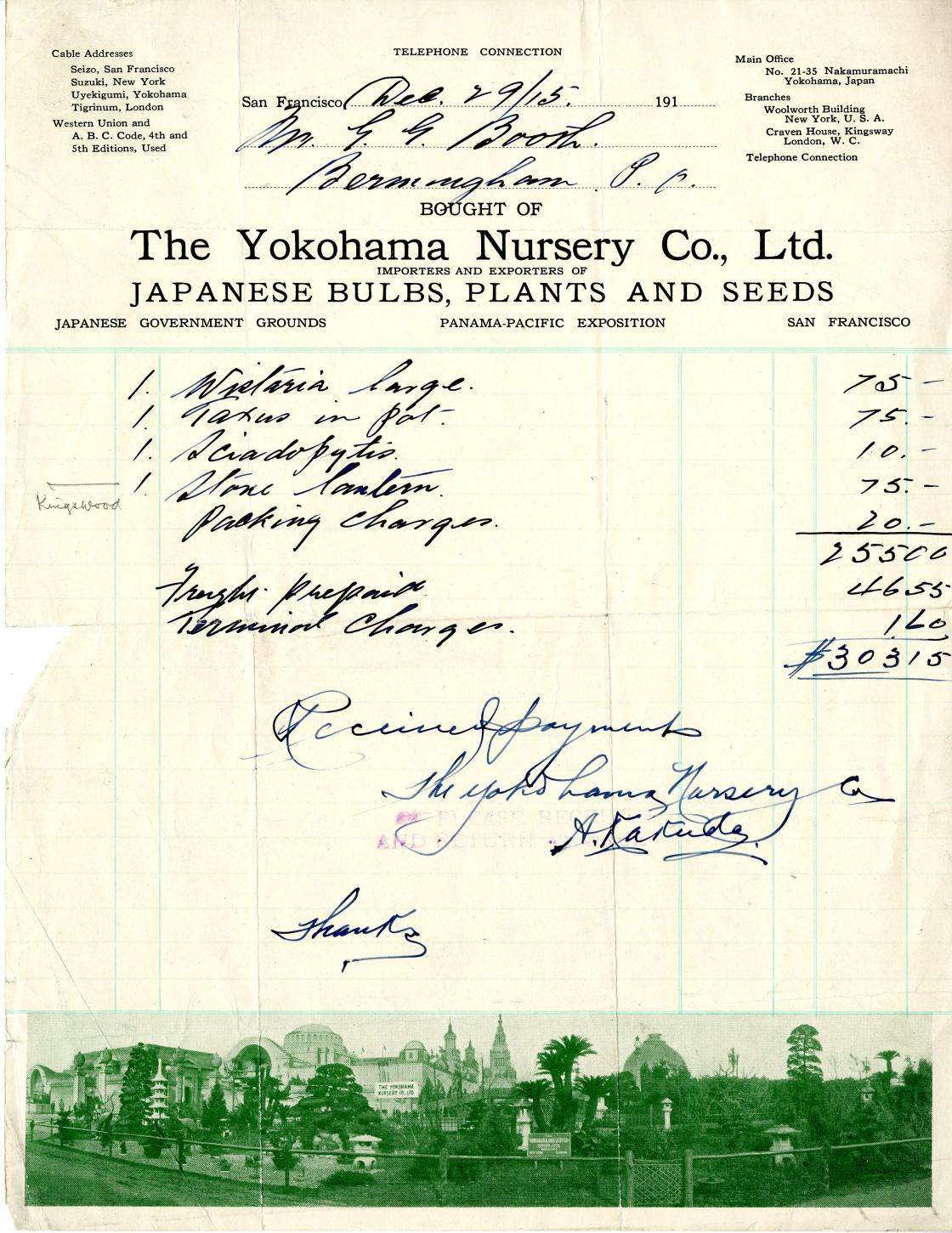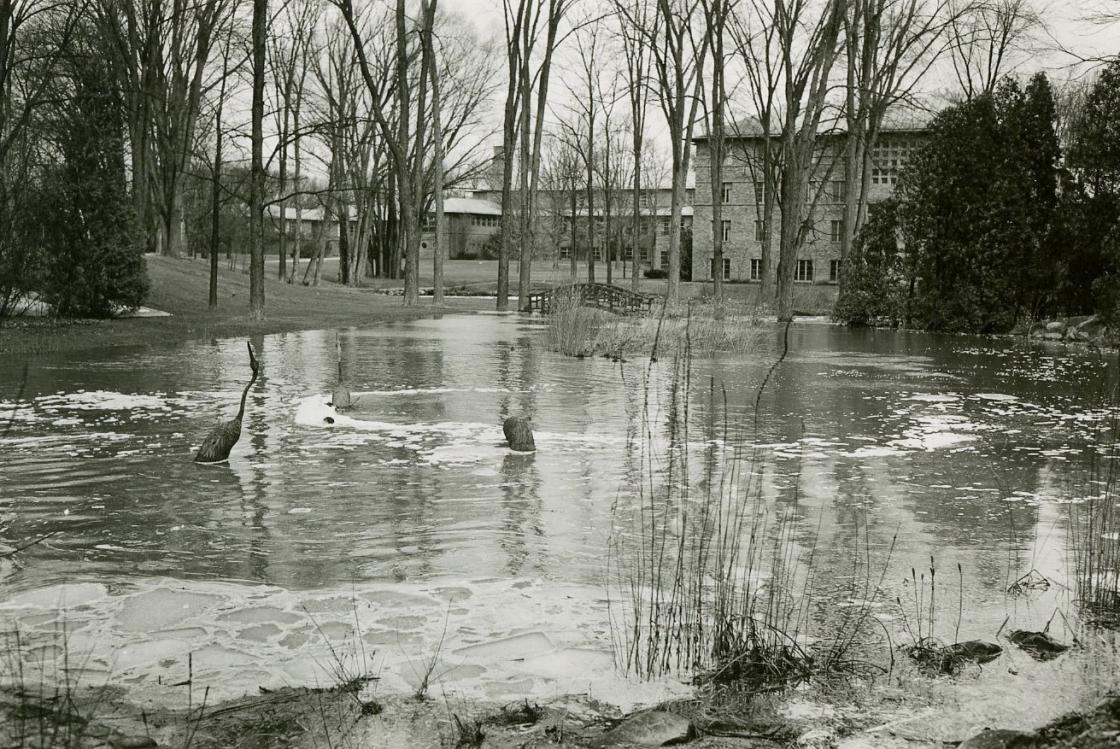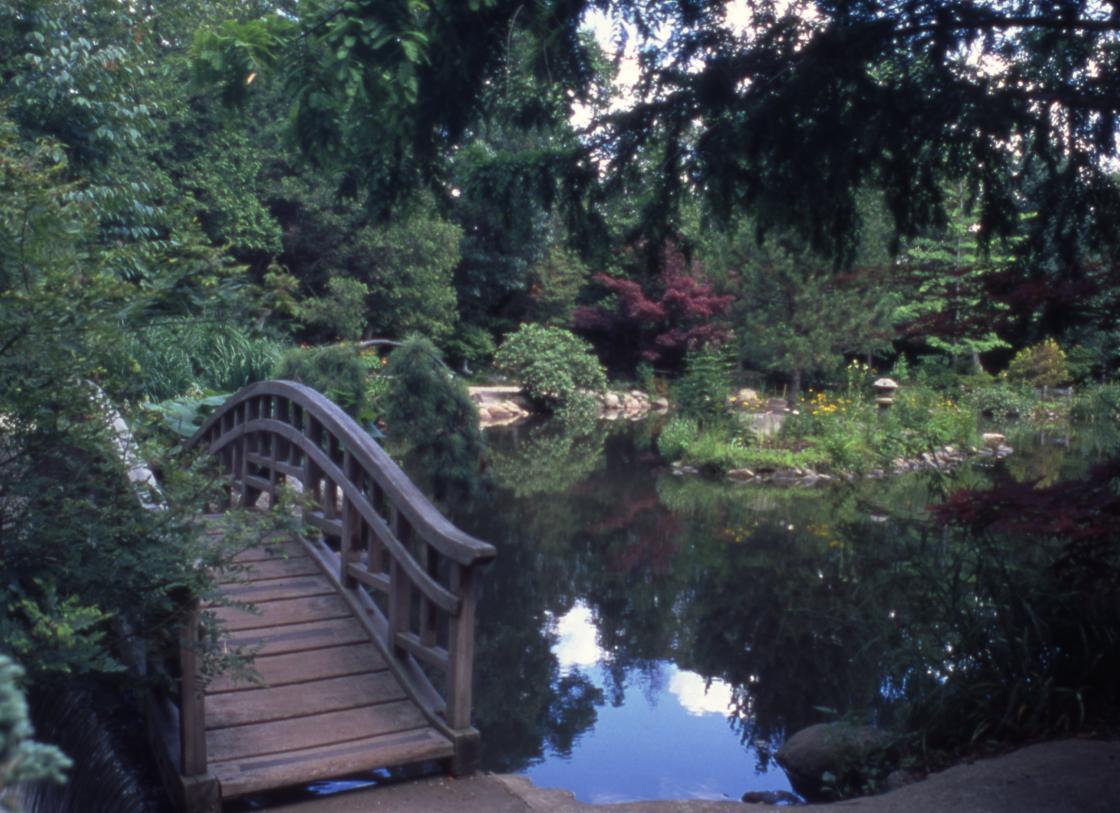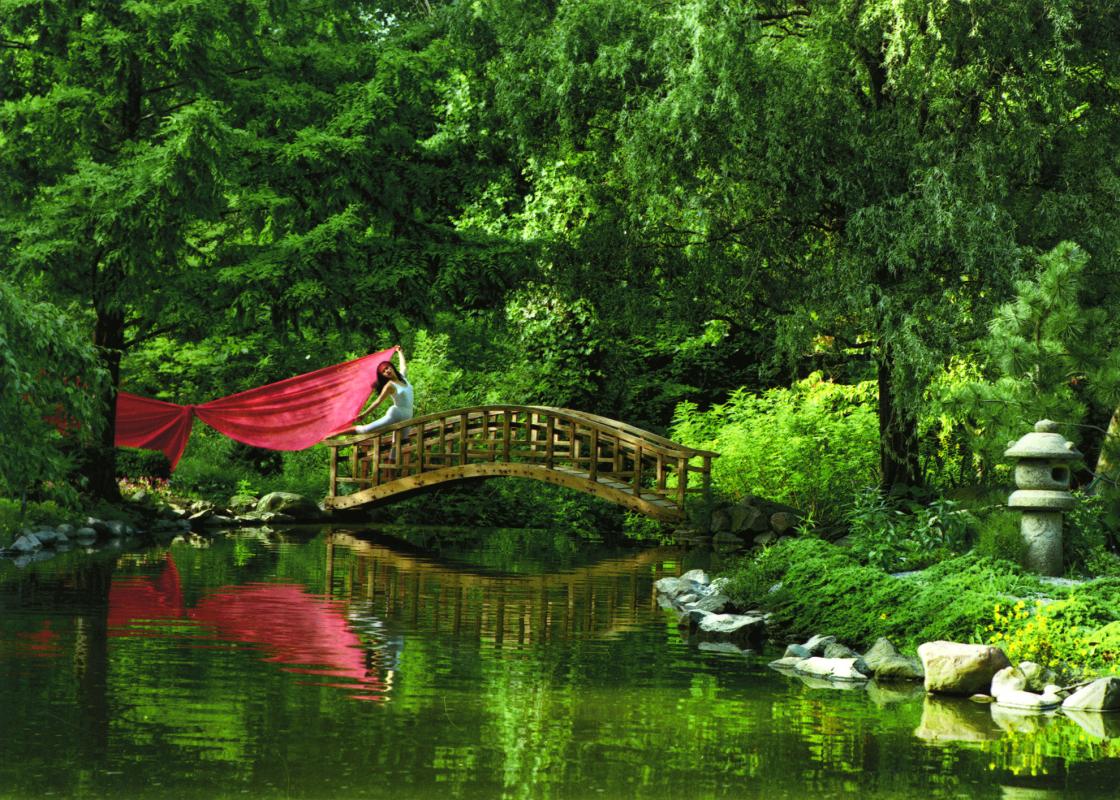japanese garden timeline: EARLY HISTORY TO 2012
Early History: Picnic Grounds, Water Systems, and the Rock Garden [1]
circa 1910: Fourth of July picnics are held on the site under a large oak.
1910: George Booth has a well dug to provide water to the picnic site and a fountain is installed for decorative use of the well water.
1912: With Italian laborers, a workhorse named Bebe, and himself, George Booth’s father Henry Wood Booth begins moving rocks around the area, forming what he called the “Rock Garden” on the site. At the same time, two water gates are installed, one at the east end of Glassenbury (now Kingswood) Lake and one at the south end of the millrace running along the eastern edge of the property.
1913: The Spillway and the Serpentine Brook (now adjacent to the Kingswood Campus) are established between Glassenbury Lake and the edge of the property at Cranbrook Road. Four temporary wooden bridges are built over these new waterways.
1914: Albert Charpaize, an expert French landscape gardener, oversees construction of five wooden bridges: one across the entrance to the millpond from the lake, one across the Serpentine Brook near the spillway, another across the same brook near Cranbrook Road, and one each across Sunny Brook and Stoney Brook elsewhere on the estate.
1914: Alexander L. Lamond, a Scotsman, begins his tenure as head gardener (working through 1933). He is involved in the planning of the Japanese Garden area, although he is better known for his work on the formal gardens around the house.
1914: Japanese Garden area is referred to as the “Lily Pond” on an appraisal map drawn by Coats & Burchard Co. of Chicago. The pond is shown with two islands and fieldstone-lined banks, and the Lily Pond Cascade (which runs from the Willow Pool immediately above the Lily Pond into the Lily Pond) and the Flowing Well Cascade (from the well-fed fountain into the Lily Pond) are called out on the map. The appraisal also lists the “Jap [sic] Bridge Dam” and the “Jap [sic] Bridge,” verifying that the Japanese Bridge was in place by 1914. [2]
The World’s Fairs and the Making of Cranbrook’s Japanese Garden
1915, March: Ellen Scripps Booth, George Gough Booth, and his father Henry Wood Booth travel to California and visit the expositions at San Diego (Panama—California Exposition, open from January 1, 1915, to January 1, 1917) and San Francisco. (Panama—Pacific International Exposition, open from February 20 to December 4, 1915).
1915, March 31: George Booth purchases a set of three bronze storks from S. & G. Gump Company, an importer of fine art and artifacts based in San Francisco with offices in Paris, Berlin, Florence, Yokohama, and Canton (Guangzhou). Receipts show he paid for the storks on May 14 and that they were in place by May 16. This order from S. & G. Gump included other items for Cranbrook House, including a Blanc d’Ivoire vase by Tozan, an ivory ball, two oil paintings, and a complimentary rhinoceros horn cup. [3]
1915, May: George Booth writes to his son, Henry Scripps Booth, “We have our three bronze storks down in the rock garden and they give the place more of a Japanese look.”[4]
1915: Henry Scripps Booth captions a photo of the Japanese Bridge, “In the Rock Garden,” in Volume 2 of his Pleasures of Life albums. [5]
1915: Henry Wood Booth refers to the “Japanese Garden” in his Annals.[6]
1915, Dec. 29: George Booth places an order for plants and a stone lantern from “The Yokohama Nursery Co., Ltd. Importers and Exporters of Japanese Bulbs, Plants, and Seeds, Japanese Government Grounds, Panama-Pacific Exposition, San Francisco.” He purchases one large wisteria, one potted Taxus (likely Taxus cuspidate, Japanese yew tree), one Sciadopitys (Japanese umbrella-pine), and one stone lantern. This is the largest stone lantern in the garden, and it remains in its original location from 1916.[7]
1916: Henry Scripps Booth captions a photograph of his friend sitting on the Japanese Bridge, “John Steketee in the Japanese Garden, 1916,” also from Volume 2 of Pleasures of Life.[8]
1930s: The Cranbrook Foundation publishes a postcard view of the garden (photographed by George W. Hance) calling it “The Japanese Garden.”

Between the Second World War and the Twenty-first Century
1940s: During World War II, many Japanese Gardens in American were rebranded as Oriental Gardens. At Cranbrook, the Japanese Garden became increasingly referred to as “Kingswood’s Oriental Garden.” Sometime between 1940 and 1955, the Japanese Bridge is painted (most likely red) for the first time, as images in the late 1930s show it unpainted and a black and white 1955 image clearly shows it painted.[9]
1957: Spring floods breach the dam from Kingswood Lake into the Japanese Garden, washing tons of soil and rocks through the area. The garden was already overgrown with trees, brush, wild daylilies, grapevines, and thorny briars, and the flood only increased the area’s feeling of neglect.[10] The washed out bridge is repaired later that year: a new deck is installed, with angle bar and bolts at each of the railing’s posts adding strength to the original design. The railings are installed backwards (with the decorative lower curve now facing the interior of the bridge).

1972: Dorothy Moroff and her dog “rediscover” the overgrown Japanese Garden (then known as the Oriental Garden).[11] Head of Kingswood School, Wilfred Hemmer, gives Cranbrook Gardens Auxiliary volunteer Rudy Fedus permission to reclaim the garden, which he does with the help of Dorothy Moroff, Sally Riemenschneider, Jane Zich, and others.[12] A retired head gardener at a private estate in Southfield, Michigan, Fedus clears away significant overgrowth within the garden and reveals the (likely Booth-era) perennials specific to a Japanese garden. Kingswood School gives the Auxiliary financial support for new gravel paths, while Fedus, Sally Barnhart, and Barnhart’s mother, Lee Armiger, donate new plant material (trees, shrubs, and ground cover). Fedus repairs the Japanese Bridge, removes rocks that had been pushed or fallen into the pond, and re-digs the stream from Willow Pond and lines it with stones. He uses fallen cedar trees for steps, railings, and a bench while also reworking the watering system from the well to the pond. He also adds new stone steps leading down from the upper part of the garden. Fedus and eight members of the Auxiliary solely dedicated to the Oriental Garden completed this work.
Note: While it is often repeated, the idea that the then-Oriental Garden was “rediscovered” is slightly romantic, as the garden is an almost annual feature in the Kingswood Yearbook Woodwinds and the garden appears on most all maps of Cranbrook throughout the century.
1973, April 10: With the passing of Cranbrook Gardens Auxiliary member Adah Glenn, the membership raises $500 for “planting something in the Japanese Garden” in her memory. A dogwood tree was planted by August 1974.[13]
1975: Mrs. George Trumbull makes a large gift of plants for the Japanese Garden then being “transformed into an exquisite gem” by Rudy Fedus. Meanwhile, a wedding of two Kingswood teachers takes place in the garden, a testament to its renewed beauty.[14] Later in 1975, the garden was damaged “extensively” in a storm, according to Henry Booth.

1978: Auxiliary Board meeting minutes show the Buildings and Grounds chair reporting that the “Oriental Garden bridge should be painted red, along with repainting planters and benches.”
1979: The first proposal from the Auxiliary to change the name of the garden from “Kingswood’s Oriental Garden” to “Kingswood’s Japanese Garden” appears in the board meeting minutes. [15] The safety of visitors to the gardens (specifically on the bridge and at steps) is also repeatedly discussed at Auxiliary meetings.
1984: Ralph Mize is hired to draw up plans for the Oriental Garden. Mize would deal primarily with water issues on the site.[16]
1987: Another major flood breaches Kingswood Lake dam, causing damage to trees and plants in the Japanese Garden. The Japanese Bridge is reworked with removable boards below it to allow more water to pass through.[17] In what may have been an effort to restore it to its Booth-era appearance, the Japanese Bridge is stripped of its red paint by Jack Wells. Wells spends the summer stripping the bridge by hand, and it is left natural for at least a year (as evidenced in yearbook images and campus views by Balthazar Korab). Student and community complaints result in the repainting of the bridge red by the end of the decade.
1988: The water system through the Japanese Garden is professionally dredged.[18]

1989: The House and Gardens Auxiliary removes the Japanese Garden from its tours until it can be properly maintained and replanted. Vi Reghanti donates a matching gift for more trees and shrubs for the garden.[19]
1989, March 27: Commissioned by the Auxiliary, landscape plans by S. Polewski propose new plans for the entire Japanese Garden, under the name “Oriental Garden.”[20]
1989-1994: The Auxiliary asks Alexander Nursery, Inc., of Clinton Township, to create a set of drawings under the project title “Japanese Garden Restoration.” The nursery closed and this proposal is not implemented.
1991 or 1992: About eight inches at the end of the bridge’s railing is knocked off.
1994, June: Auxiliary asks Jim Slezinski of Goldner Walsh Nursery, Inc., in Pontiac, to prepare plans for the “New South Entry and Gateway” and the “Renovation of Eastern Shore” of the garden using the project title: “Cranbrook – Oriental Garden.” This plan is implemented and the “Official Opening of Phase I of Our Oriental Garden Renovation” takes place on May 31, 1995. This is when the Tori Gate was added to the garden.
1997, March: Auxiliary returns to Slezinski of Goldner Walsh Nursery for plans dealing with the “Northwest Section” and the “Northeast Section” of the garden. These plans were not implemented, in part, because of a flood that occurs in the late 1990s.

1998: Ralph Graham, volunteer for the House & Gardens Auxiliary, begins a thirteen-year commitment to the Japanese Garden following his retirement from business. He asks for the Japanese Garden to be placed back under Cranbrook Educational Community jurisdiction, with the belief that it will be better maintained than if it remained under the Auxiliary. The Community maintained the garden for two years, after which Graham returned as its chief champion and patron through the next decade.[21]
2012: The Cranbrook Center for Collections and Research is founded.
Kevin Adkisson, Collections Fellow
Center for Collections and Research
June 2017
RELATED LINKS
Japanese Garden Brief History
Japanese Garden Timeline: 2012 to the Present
Japanese Garden Lily Pond Cascade
Japanese Bridge
Japanese Kasuga Lantern
Sadafumi Uchiyama
Visit the Japanese Garden
Endnotes
1.Leslie S. Edwards. “Oriental Garden Timeline,” revised May 2016. Cranbrook Archives.
2.Coats & Burchard Co. "AD.01.140). Cranbrook Archives.
3.George G. Booth Papers, Cranbrook Archives, Bloomfield Hills, Michigan. S. & G. Gump Company Receipt of order, March 31, 1915. Cranbrook Archives.
4.George G. Booth Papers, Cranbrook Archives, Bloomfield Hills, Michigan. Correspondence from George G. Booth to Henry Scripps Booth, 16 May 1915.
5.Henry Scripps Booth and Carolyn Farr Booth Papers, Cranbrook Archives, Bloomfield Hills, Michigan. Pleasures of Life, 1915-16, Book 2, Page 44, image 4 (POL2.44.4).
6.Henry Scripps Booth and Carolyn Farr Booth Papers, Cranbrook Archives, Bloomfield Hills, Michigan. Annals, 1915.
7.George G. Booth Papers, Cranbrook Archives, Bloomfield Hills, Michigan. Yokahama Nursery Co., Ltd. receipt of order, Dec. 5, 1915. Cranbrook Archives.
8.Henry Scripps Booth and Carolyn Farr Booth Papers,Cranbrook Archives, Bloomfield Hills, Michigan. Pleasures of Life, 1915-16, Book 2, Page 88, Image 3.
9.Kingswood School for Girls. Woodwinds, 1939-1955, the yearbook for the Kingswood School for Girls. Cranbrook Archives.
10.Leslie Edwards, “Oriental Garden Timeline,” revised May 2016. Cranbrook Archives.
11.Betty Trost Collection, Cranbrook Archives, Bloomfield Hills, Michigan (2005-07). Cranbrook Archives.
12.Leslie S. Edwards. “Oriental Garden Name History,” revised May 2016. Cranbrook Archives.
13.Cranbrook House & Gardens Auxiliary. Board meeting minutes, April 10, 1974
Cranbrook House & Gardens Auxiliary. Board meeting minutes, August 5, 1973
14.Cranbrook House & Gardens Auxiliary. Board meeting minutes, February 3, 1975
Cranbrook House & Gardens Auxiliary. Board meeting minutes, June 30, 1975
Cranbrook House & Gardens Auxiliary. Board meeting minutes, April 16, 1975
15.Cranbrook House & Gardens Auxiliary. Board meeting minutes, 1979 miscellaneous business
16.Cranbrook House & Gardens Auxiliary. Board meeting minutes, March 4, 1986
17.Ralph Mize, interview by Judy Lindstrom on Oriental Garden Water Control, November 16, 1993. Courtesy of Lindstrom family papers, Birmingham, Michigan.
18.Cranbrook House & Gardens Auxiliary. Board meeting minutes, May 3, 1988
19.Cranbrook House & Gardens Auxiliary. Board meeting minutes, June 6, 1989; Cranbrook House & Gardens Auxiliary. Board meeting minutes, October 3, 1989
20.S. Polewski, "Japanese Garden: concept" (AD.04.165). March 27, 1989. Courtesy of Cranbrook Archives.
21.Judy Lindstrom. Email message to Gregory Wittkopp, February 16, 2016.
photo credits
Booth, Henry Scripps. View from the Oriental Garden looking towards the Kingswood Lake dam. 1919. Cranbrook Archives, Cranbrook Center for Collections and Research, Bloomfield Hills.
Yokohama Nursery Co. receipt. December 1915. George G. Booth Papers, Cranbrook Archives, Cranbrook Center for Collections and Research, Bloomfield Hills.
Croze, Harvey. Japanese Garden (flooded), n.d. Cranbrook Archives, Cranbrook Center for Collections and Research, Bloomfield Hills.
Korab, Balthazar. Japanese Garden Bridge. May 2001. Copyright Balthazar Korab/Cranbrook Archives. Cranbrook Archives, Cranbrook Center for Collections and Research, Bloomfield Hills.
Olds, Fred. Cranbrook Kingswood Upper School dancer, Georgeanna Cheung, on the Japanese Bridge.1994. Copyright Fred Olds. Courtesy Cranbrook Archives, Cranbrook Center for Collections and Research, Bloomfield Hills.
Tori Gate, Japanese Garden. 1995. Cranbrook Archives, Cranbrook Center for Collections and Research, Bloomfield Hills.
Banner photo by P.D. Rearick, CAA '10.
